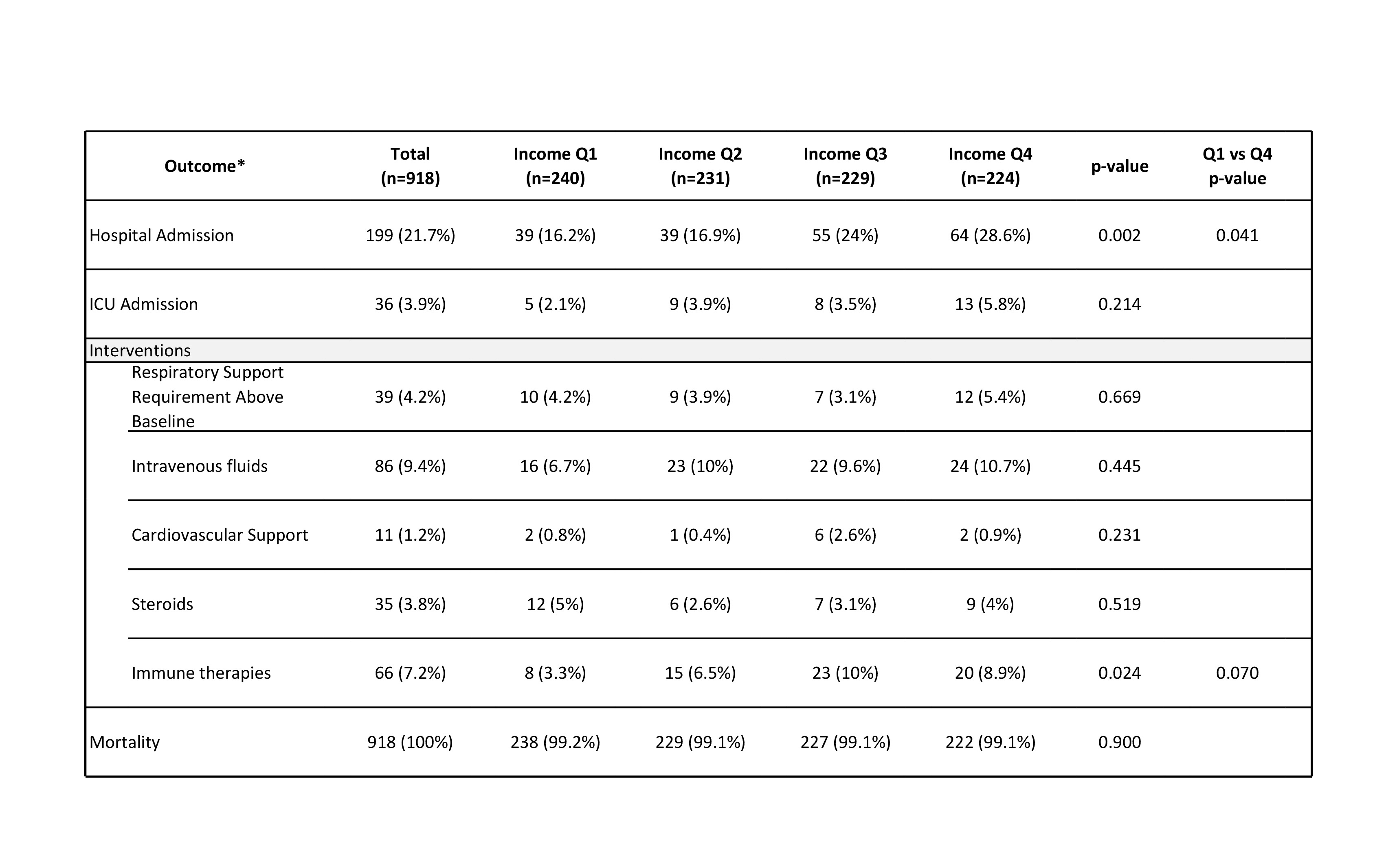Emergency Medicine: All Areas
Category: Abstract Submission
Emergency Medicine IV
85 - Severity of clinical outcomes of COVID-19 infection in pediatric patients by socioeconomic status
Friday, April 22, 2022
6:15 PM - 8:45 PM US MT
Poster Number: 85
Publication Number: 85.106
Publication Number: 85.106
Swati Goel, Children's Hospital of Philadelphia, Philadelphia, PA, United States; Lauren M. Klingensmith, Children's Hospital of Philadelphia, Philadelphia, PA, United States; Vinay Kampalath, Childrens Hospital of Philadelphia, Philadelphia, PA, United States; Keri Cohn, Perelman School of Medicine at the University of Pennsylvania, Philadelphia, PA, United States

Swati Goel, MD
Resident Physician
Children's Hospital of Philadelphia
Philadelphia, Pennsylvania, United States
Presenting Author(s)
Background: The prevalence of the SARS-CoV-2 virus (which causes COVID-19 infection) is at historically high levels worldwide. Literature from adult cohorts suggests worse outcomes for lower-income COVID-19 patients (compared with higher-income patients), but little is known about how socioeconomic status (SES) affects disease outcomes for children.
Objective: We investigated the severity of disease outcomes among pediatric patients from different socioeconomic status quartiles with COVID-19 infection.
Design/Methods: This study evaluated a retrospective cohort of patients between March 2020 and October 2021, aged birth through 18 years, who tested positive for SARS-CoV-2 in an emergency department at a large urban, academic children’s hospital. Median income for the patient’s residential zip code, obtained from the U.S. Census Bureau 2019, was used as a proxy for socioeconomic status. Cohorts were divided into four quartiles based on median household income: Q1($20,353-$33,265), Q2($33,265-$45,253), Q3($45,253-$54,800), and Q4( >$54,800). Bivariate analyses with chi-square tests were completed to evaluate the odds of disease outcomes, stratified by SES. A comparison between Q1 and Q4 was used when there was a significant difference determined between all quartiles. Multivariate logistic regression was used to assess other predictors of hospital admission.
Results: A sample of 918 patient charts were retrieved representing approximately 224-240 patients in each quartile. There was no difference in SARS-CoV-2 strain (delta compared to earlier strains), sex, or age distribution between Q1 and Q4. There was a larger proportion of patients of African American race and with public insurance within Q1. Bivariate analyses revealed a larger proportion of patients admitted to the hospital within Q4 than within Q1 (p=0.04). However, when adjusted for sex, age, race, ethnicity, insurance type, presence of comorbidity, and acuity, there was no statistically significant difference between odds of admission for each quartile compared to Q4. When adjusted for everything else including race, patients with public insurance were 1.76 times more likely to be admitted (95% CI 1.04-3.02) compared to private insurance.Conclusion(s): Severity of COVID-19 disease outcomes including hospital admission were similar across children, regardless of SES, although publicly insured patients had higher rates of admission than privately insured children.
CV for Swati GoelAbbreviated CV_Swati Goel_v2022-01.pdf
Table 2: Clinical outcomes by socioeconomic status *Reported as N (%), unless otherwise noted. Cardiovascular support includes vasopressor requirement, ECMO, transfusions. Immune therapies include antibiotics, antiviral medication, convalescent plasma. P-values < 0.05 were considered to represent statistical significance. Comparison of Q1 and Q4 only done when initial p-value comparing all income quartiles < 0.05.
*Reported as N (%), unless otherwise noted. Cardiovascular support includes vasopressor requirement, ECMO, transfusions. Immune therapies include antibiotics, antiviral medication, convalescent plasma. P-values < 0.05 were considered to represent statistical significance. Comparison of Q1 and Q4 only done when initial p-value comparing all income quartiles < 0.05.
Objective: We investigated the severity of disease outcomes among pediatric patients from different socioeconomic status quartiles with COVID-19 infection.
Design/Methods: This study evaluated a retrospective cohort of patients between March 2020 and October 2021, aged birth through 18 years, who tested positive for SARS-CoV-2 in an emergency department at a large urban, academic children’s hospital. Median income for the patient’s residential zip code, obtained from the U.S. Census Bureau 2019, was used as a proxy for socioeconomic status. Cohorts were divided into four quartiles based on median household income: Q1($20,353-$33,265), Q2($33,265-$45,253), Q3($45,253-$54,800), and Q4( >$54,800). Bivariate analyses with chi-square tests were completed to evaluate the odds of disease outcomes, stratified by SES. A comparison between Q1 and Q4 was used when there was a significant difference determined between all quartiles. Multivariate logistic regression was used to assess other predictors of hospital admission.
Results: A sample of 918 patient charts were retrieved representing approximately 224-240 patients in each quartile. There was no difference in SARS-CoV-2 strain (delta compared to earlier strains), sex, or age distribution between Q1 and Q4. There was a larger proportion of patients of African American race and with public insurance within Q1. Bivariate analyses revealed a larger proportion of patients admitted to the hospital within Q4 than within Q1 (p=0.04). However, when adjusted for sex, age, race, ethnicity, insurance type, presence of comorbidity, and acuity, there was no statistically significant difference between odds of admission for each quartile compared to Q4. When adjusted for everything else including race, patients with public insurance were 1.76 times more likely to be admitted (95% CI 1.04-3.02) compared to private insurance.Conclusion(s): Severity of COVID-19 disease outcomes including hospital admission were similar across children, regardless of SES, although publicly insured patients had higher rates of admission than privately insured children.
CV for Swati GoelAbbreviated CV_Swati Goel_v2022-01.pdf
Table 2: Clinical outcomes by socioeconomic status
 *Reported as N (%), unless otherwise noted. Cardiovascular support includes vasopressor requirement, ECMO, transfusions. Immune therapies include antibiotics, antiviral medication, convalescent plasma. P-values < 0.05 were considered to represent statistical significance. Comparison of Q1 and Q4 only done when initial p-value comparing all income quartiles < 0.05.
*Reported as N (%), unless otherwise noted. Cardiovascular support includes vasopressor requirement, ECMO, transfusions. Immune therapies include antibiotics, antiviral medication, convalescent plasma. P-values < 0.05 were considered to represent statistical significance. Comparison of Q1 and Q4 only done when initial p-value comparing all income quartiles < 0.05.